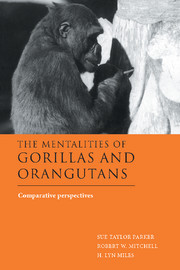Book contents
- Frontmatter
- Contents
- List of contributors
- Preface
- Acknowledgments
- I Comparative evolutionary and developmental perspectives on gorillas and orangutans
- II Cognition and tool use in gorillas and orangutans
- 4 Intelligent tool use in wild Sumatran orangutans
- 5 Orangutans' imitation of tool use: a cognitive interpretation
- 6 Object manipulation and skill organization in the complex food preparation of mountain gorillas
- 7 Development of sensorimotor intelligence in infant gorillas: the manipulation of objects in problem-solving and exploration
- 8 Tool use in captive gorillas
- 9 A survey of tool use in zoo gorillas
- III Communication in gorillas and orangutans
- IV Social cognition in gorillas and orangutans
- V Epilogue
- Index of authors
- Index of subjects
8 - Tool use in captive gorillas
Published online by Cambridge University Press: 20 October 2009
- Frontmatter
- Contents
- List of contributors
- Preface
- Acknowledgments
- I Comparative evolutionary and developmental perspectives on gorillas and orangutans
- II Cognition and tool use in gorillas and orangutans
- 4 Intelligent tool use in wild Sumatran orangutans
- 5 Orangutans' imitation of tool use: a cognitive interpretation
- 6 Object manipulation and skill organization in the complex food preparation of mountain gorillas
- 7 Development of sensorimotor intelligence in infant gorillas: the manipulation of objects in problem-solving and exploration
- 8 Tool use in captive gorillas
- 9 A survey of tool use in zoo gorillas
- III Communication in gorillas and orangutans
- IV Social cognition in gorillas and orangutans
- V Epilogue
- Index of authors
- Index of subjects
Summary
Ethological and experimental investigations of tool use have been explored across a wide range of mammalian and avian species, with the extensive review by Beck (1980) still the penultimate volume. The initial field observations of tool use in wild chimpanzees (Pan troglodytes) came from the pioneering work of Goodall (1964, 1968), and were followed by meticulous reports from McGrew (e.g., 1974, 1987; Brewer & McGrew, 1990; for overview, see 1992), detailing two different types of tool use, including termite-fishing and ant-dipping. Subsequent observations of tool use, modification, and transport, including stone tool use by chimpanzees, have provided a window toward understanding cultural transmission among populations of chimpanzees now isolated throughout eastern and western Africa (Boesch & Boesch, 1990; McGrew, 1992; Matsuzawa, 1994). As numerous field workers continue to collect long-term data and behavioral observations of wild chimpanzee populations, new tool types and functions are regularly reported (Sugiyama, 1985, 1995; McGrew, 1992; Suzuki, Kuroda, & Nishihara, 1995; Yamakoshi & Sugiyama, 1995).
The rich archival literature now available on primate tool use, particularly for chimpanzees, coupled with increased awareness of the positive effects of environmental enrichment for captive primates, have resulted in a wide range of creative and innovative efforts at providing captive great apes opportunities for tool use in both zoo and laboratory settings. Despite this history of research, opinions of what can be classified as a tool or tool use vary. In accordance with Goodall (1970), Parker & Gibson (1977), and, more recently, Boesch & Boesch (1990), the present study defines a tool as an object that is held in the hand, foot, or mouth and employed in a functional manner that enables the user to attain a specific goal.
- Type
- Chapter
- Information
- The Mentalities of Gorillas and OrangutansComparative Perspectives, pp. 179 - 187Publisher: Cambridge University PressPrint publication year: 1999
- 10
- Cited by



